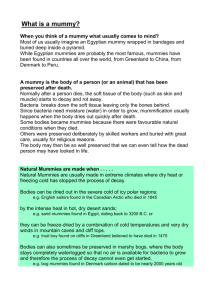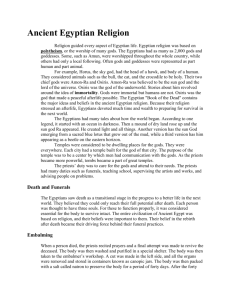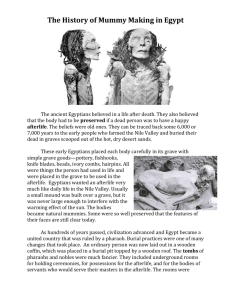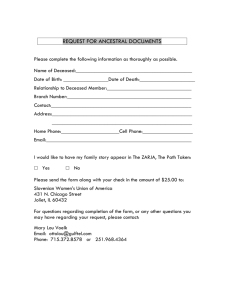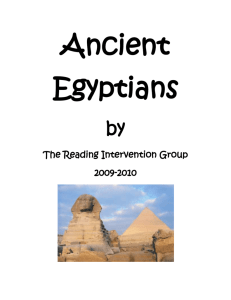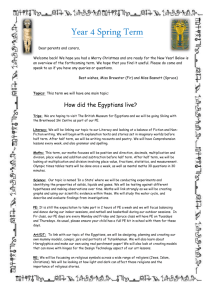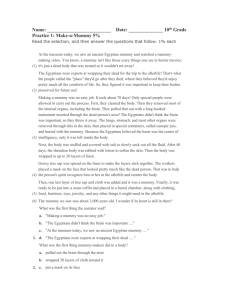Mummies - Alvin ISD
advertisement
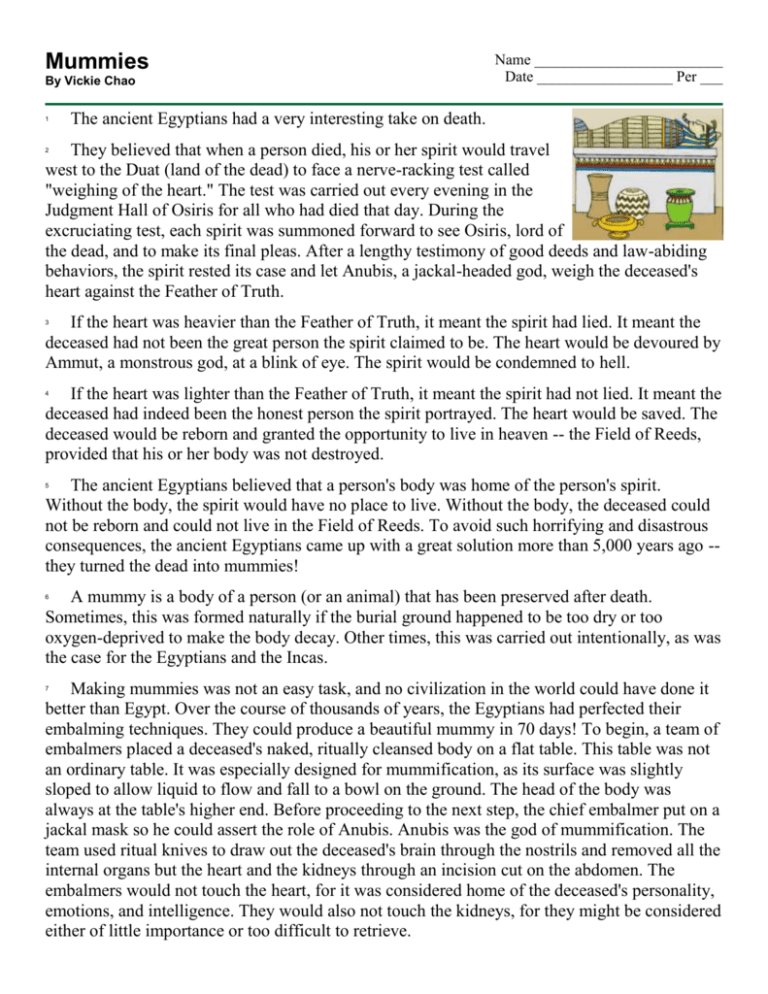
Mummies By Vickie Chao 1 Name _________________________ Date __________________ Per ___ The ancient Egyptians had a very interesting take on death. They believed that when a person died, his or her spirit would travel west to the Duat (land of the dead) to face a nerve-racking test called "weighing of the heart." The test was carried out every evening in the Judgment Hall of Osiris for all who had died that day. During the excruciating test, each spirit was summoned forward to see Osiris, lord of the dead, and to make its final pleas. After a lengthy testimony of good deeds and law-abiding behaviors, the spirit rested its case and let Anubis, a jackal-headed god, weigh the deceased's heart against the Feather of Truth. 2 If the heart was heavier than the Feather of Truth, it meant the spirit had lied. It meant the deceased had not been the great person the spirit claimed to be. The heart would be devoured by Ammut, a monstrous god, at a blink of eye. The spirit would be condemned to hell. 3 If the heart was lighter than the Feather of Truth, it meant the spirit had not lied. It meant the deceased had indeed been the honest person the spirit portrayed. The heart would be saved. The deceased would be reborn and granted the opportunity to live in heaven -- the Field of Reeds, provided that his or her body was not destroyed. 4 The ancient Egyptians believed that a person's body was home of the person's spirit. Without the body, the spirit would have no place to live. Without the body, the deceased could not be reborn and could not live in the Field of Reeds. To avoid such horrifying and disastrous consequences, the ancient Egyptians came up with a great solution more than 5,000 years ago -they turned the dead into mummies! 5 A mummy is a body of a person (or an animal) that has been preserved after death. Sometimes, this was formed naturally if the burial ground happened to be too dry or too oxygen-deprived to make the body decay. Other times, this was carried out intentionally, as was the case for the Egyptians and the Incas. 6 Making mummies was not an easy task, and no civilization in the world could have done it better than Egypt. Over the course of thousands of years, the Egyptians had perfected their embalming techniques. They could produce a beautiful mummy in 70 days! To begin, a team of embalmers placed a deceased's naked, ritually cleansed body on a flat table. This table was not an ordinary table. It was especially designed for mummification, as its surface was slightly sloped to allow liquid to flow and fall to a bowl on the ground. The head of the body was always at the table's higher end. Before proceeding to the next step, the chief embalmer put on a jackal mask so he could assert the role of Anubis. Anubis was the god of mummification. The team used ritual knives to draw out the deceased's brain through the nostrils and removed all the internal organs but the heart and the kidneys through an incision cut on the abdomen. The embalmers would not touch the heart, for it was considered home of the deceased's personality, emotions, and intelligence. They would also not touch the kidneys, for they might be considered either of little importance or too difficult to retrieve. 7 As the "surgery" came to its conclusion, the embalmers examined all the contents taken out and kept only the deceased's stomach, intestines, liver, and lungs. They packed the four organs, along with the body itself, with natron. Natron was a kind of natural salt, perfect for absorbing bodily fluids. The embalmers used it to dry out the four organs and the body so they would not decay. The entire drying process was the longest part of mummification. It took about 40 days. Upon its completion, the embalmers wrapped the four organs in linens and placed them in four separate jars. Those jars, often depicted with images of gods, were called canopic jars. 8 After the organs were taken care of, the embalmers began embellishing the body. They stuffed it with things like linens and sawdust in order to give the empty, sapped shape a life-like appearance. They massaged it with oil and perfume to make the dried skin supple and smell nice. They poured melted pine resin over it to stop it from going moldy. They placed a plate bearing the sacred symbol of the protective eye of Horus over the incision cut on the abdomen to cover the wound and to ward off evils. They put wigs on the deceased's head and drew makeup on the face. Once they finished dressing up the body, they laid out lots of linens. They wrapped the head, fingers, toes, arms, and legs first, followed by the torso. They used resin as the adhesive and bandaged the whole body in as many as twenty layers. They placed numerous amulets and spells in between the layers, and covered the head with a mummy mask. After the last layer of bandaging was done, they waterproofed it by pouring one last coating of resin over it. They then put the mummy into a mummy case and set out to the burial ground. 9 At the site of the tomb, right before the funeral, one person from the embalming team held the mummy case upright, while the others tapped it on the face with sacred tools. The ritual, known as "opening of the mouth", was believed to allow the mummy to see, hear, eat, and drink in its afterlife. Once that was over, the mummy case and the canopic jars were placed inside the tomb. The embalmers were now ready for their next client! Copyright © 2009 edHelper 10 Mummies 1. Which of the following about mummies is correct? Egyptian mummies were wrapped in a single layer of cotton. Mummies could only be found in Egypt. Egyptian mummies were naturally made. Like the Egyptians, the Incas also made mummies. 3. According to Egyptian legends, who was lord of the dead? Osiris Ammut Isis Anubis 2. What did the ancient Egyptians use to dry out the body during mummification? Resin Baking soda Natron Flour 4. Which of the following organs did the ancient Egyptians consider to be home of a person's intelligence? Lungs Stomach Heart Brain 5. During mummification, which of the following steps would take place first? Bandaging the deceased's body Massaging the deceased's skin with oil and perfume Putting a wig on the deceased's head Removing the deceased's lungs 7. Who was the Egyptian god of mummification? Anubis Osiris Ammut Apophis 9. Why did the ancient Egyptians make mummies? Because they had so many linens that they needed to find a way to use them Because they believed that a person could not be reborn if his or her body was destroyed Because they believed that the only way to get rid of a person's spirit was to preserve his or her body Because they wanted to scare bad children straight 6. What was the ritual that the Egyptian embalmers did right before a funeral? Opening of the mouth Opening of the ears Opening of the eyes Opening of the nose 8. Which of the following organs can we not find in a canopic jar? Intestines Kidneys Stomach Liver 10. Which of the following is true about the way an Egyptian mummy was made? An Egyptian mummy was made while the person was still alive. An Egyptian mummy had the protective eye of Horus drawn on its head. An Egyptian mummy was wrapped in several layers of linens. An Egyptian mummy had no internal organs inside.
